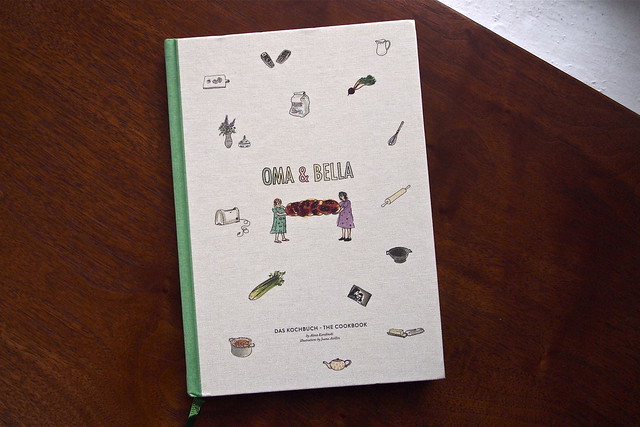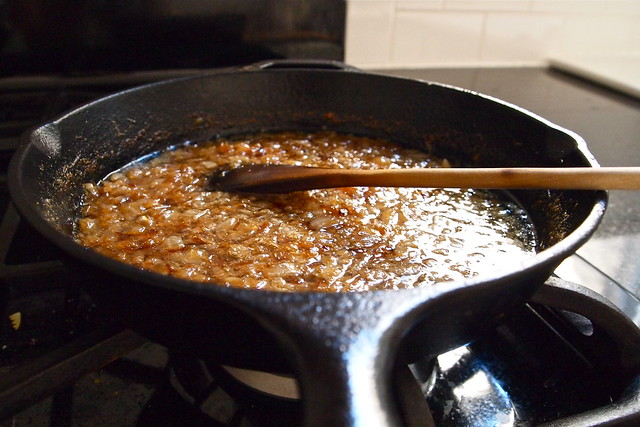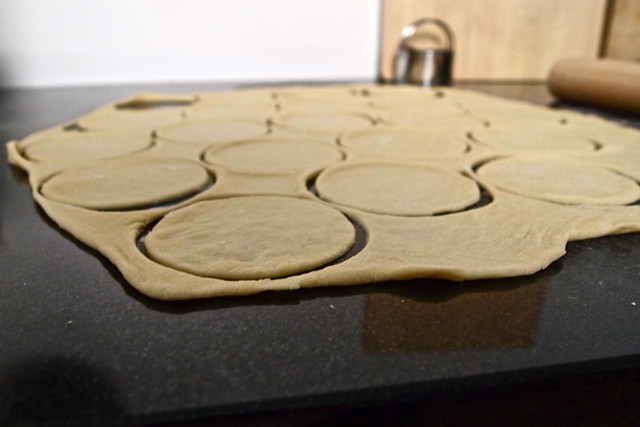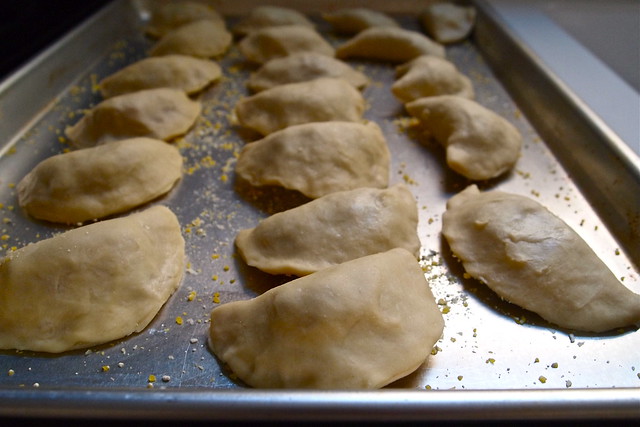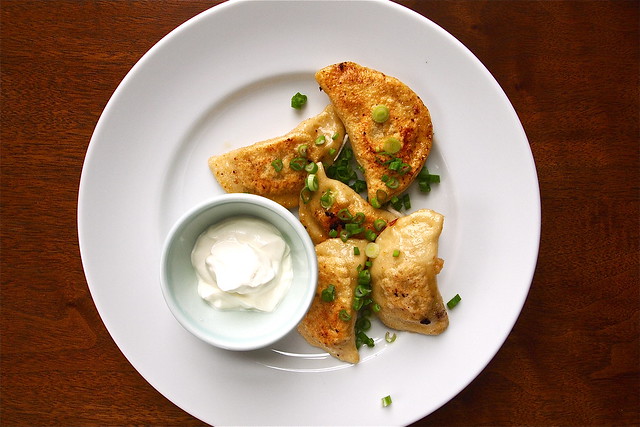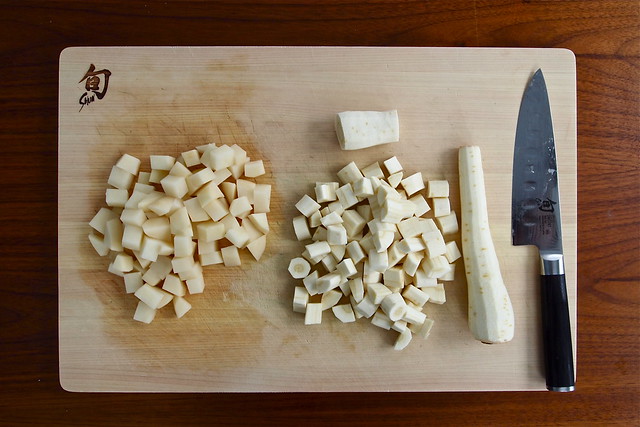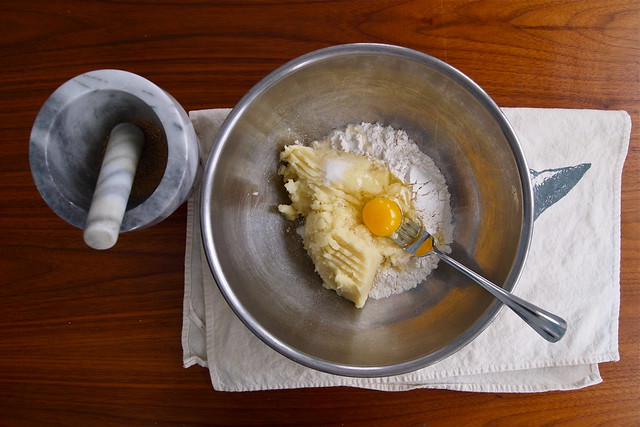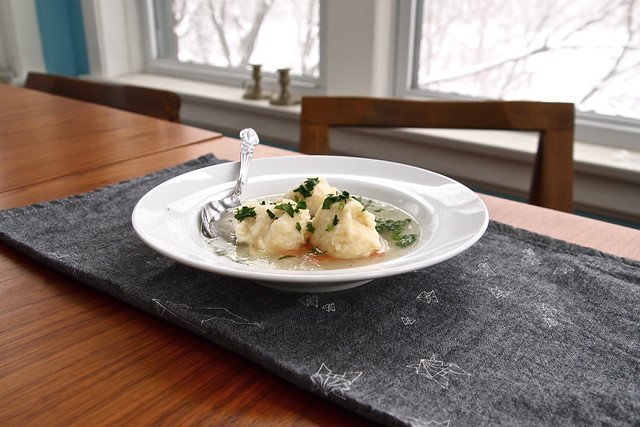A few weeks ago, Luisa wrote about Oma and Bella, a film about two women--best friends, Holocaust survivors, splendid home cooks--and their life in the kitchen. Regina and Bella (the filmmaker, Alexa Karolinski, is Regina's granddaughter, making Regina her Oma) live together in Berlin and spend their days in bright kitchen smocks hovering over simmering pots of borscht, rolling up stuffed, oversized cabbage leaves, and filling tins to the brim with sparkling cream-cheese cookies. The film, though about their lives now, is permeated with their past. The food that they prepare day-to-day is the same food they grew up eating. Now, I don't have any personal connection to any of this--to that very dark part of history, to post-war Germany, to the culture and traditions that survive with Regina and Bella. But you certainly don't need to to appreciate the film or to want to cook everything from the beautiful little book of recipes that Alexa has put together.
What I find most remarkable about Regina and Bella's cooking is that it is all pieced together from childhood memory. They alone from their respective families survived the camps, and they'd been too young at the time to learn to cook. So, after the war, they taught themselves from the flavours they remembered. And this is the same food that they cook today, that connects them to a past of which there are otherwise very few tangible traces. (In the film, Regina and Bella tell us that any survivors who were able to save family photos were very lucky.) So leafing through the cookbook, having the sweet smell of slow-roasted onions fill my kitchen (these onions are at the heart of Regina and Bella's cooking), feel to me like something of a privilege. I feel terribly lucky to be able to cook this food at all, and I am so glad that Alexa took on the project of turning their handfuls into half-cups so that we might all share in it.
Regina and Bella are firm believers in keeping their freezer well-stocked--as in, they are always prepared to feed a serious crowd with almost no notice. I really admire that. It always feels reassuring to have at least a few goodies stashed away. My own freezer stock was not (and still isn't) nearly as impressive (chicken stock, pork stock, gelatin purée, ground turkey, two sausages, marrow bones), so when my copy of the cookbook arrived in the mail, I decided to start with Regina and Bella's pierogis, with the hope of adding to it.
But I'm afraid that my freezer stock of pierogis is already nearly gone. I made a double batch, hoping that the pierogis would turn out well. But really, I should have made a quadruple batch at the very least. These pierogis are so, so good. The filling is super simple, just onion and potato. You cook down diced onions on gentle heat to a golden, sticky mass. This can take some time--over an hour in my case--but the onions don't need your undivided attention. And in the interim, you can also boil and mash a few potatoes for the filling and pull together the pierogi dough. The dough, by the way, isn't at all fussy. It can get a little dry once rolled out if you don't work quickly enough, but that is easily remedied with moistened fingertips. It will hold shut during cooking with some good, firm pinches and doesn't suffer after being handled a lot. Admittedly, with the onions to cook down, the dough to prepare, and the assembly, making these pierogis can feel like quite the production. But they are definitely worthwhile, especially if you make a big batch to stash away.
The cookbook suggests that you serve your pierogis with meatballs. We ate ours alongside braised red cabbage spiked with apple-cider vinegar and caraway seed. Alexa also says in the book that her Oma has been known to chase her pierogis with homemade pickles and shots of vodka. I just don't have the constitution for that sort of thing, but what women Regina and Bella must be!
Potato and Onion Pierogi
Adapted from Oma & Bella, The Cookbook
Note: You may end up with a little extra filling--I had maybe a 1/4 cup leftover--but I wouldn't expect this to be much of a problem. Even cold out of the fridge a day later, it was very good.
FILLING:
2 large yellow onions
125 ml / 1/2 cup vegetable oil
700 g / 1 1/2 lb starchy potatoes (about 3 medium ones)
Salt and pepper to taste
DOUGH:
380 g / 3 cups all-purpose flour + more for dusting
125 ml / 1/2 cup water
2 large eggs
Large pinch of salt
TO FINISH:
Scallions or chives, thinly sliced
Sour cream
Finely dice the onion and fry it in the oil in a large, heavy-bottomed skillet on low to medium-low heat until dark-golden brown, about 1 hour. Meanwhile, peel and boil the potatoes in a large pot of salted water until tender, about 20-25 minutes, depending on the size of your potatoes. Drain the potatoes and return them to their pot with the heat on medium, then mash them (doing things this way will help to rid the potatoes of excess water). Remove the onions from the oil with a slotted spoon (don't toss the oil--save it to fry the pierogis in or for some other use) and combine them with the mashed potato in a large bowl. Season with salt and pepper to taste.
In a large bowl, mix the flour, water, eggs, and salt with a fork until a rough dough forms. Turn the dough out onto a clean surface and knead for 5 minutes as you would pasta dough, pushing the dough away from you across the work surface with your palms and then balling it up and repeating this, using flour as necessary to prevent the dough from sticking. Cover the dough with plastic wrap or an overturned bowl for 5-10 minutes to let the dough relax. Then roll out the dough until it is only a couple of millimetres thick, again using flour as needed (it helps to have a bench scraper handy and to use it lift the dough from your work surface occasionally to prevent sticking). Use the rim of water glass or a biscuit cutter about 3 inches in diameter to cut circles out of the dough.
On each circle, place a tablespoon of the potato filling. Fold the dough over itself to form a semi-circle and seal the edges with damp fingers, pinching firmly. Place finished pierogis on a flour- or cornmeal-dusted baking sheet. (Be sure to gather up the dough scraps and re-roll them for a second or even third round of pierogis. Just keep this remaining dough covered while you're busy with assembly.) At this point you can either freeze the pierogis on the baking sheet until firm and then seal them in a bag in the freezer for later use or proceed as follows.
Bring a medium-sized pot of salted water to a boil. Place the pierogis in the boiling water. When they float to the surface, they are ready. Drain in a colander.
In a skillet over medium heat, fry the cooked pierogis, a few minutes per side, until golden brown. Serve hot with scallions and sour cream.
Makes about 30 pierogis, enough for 4-6 people as part of a larger meal.

